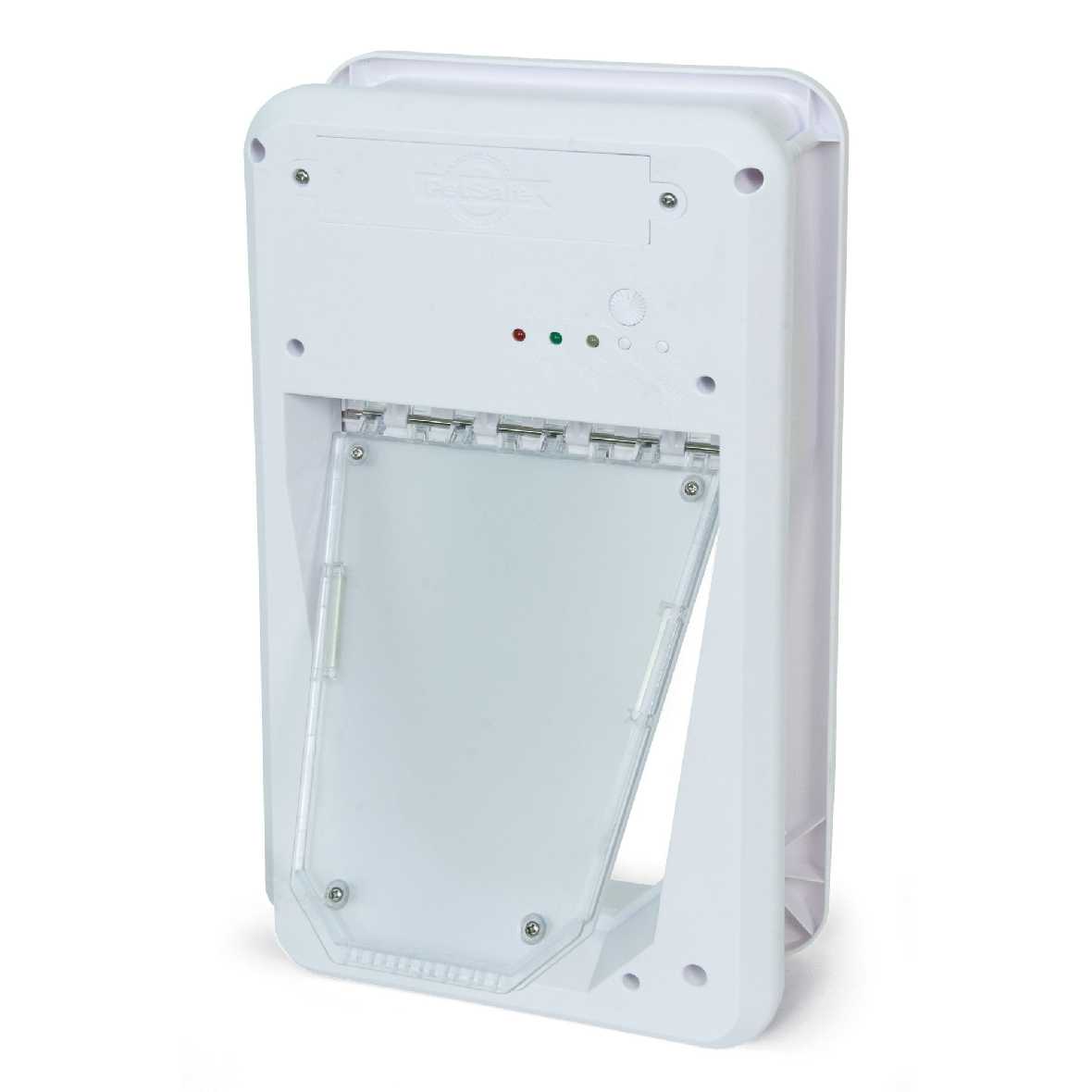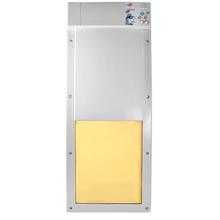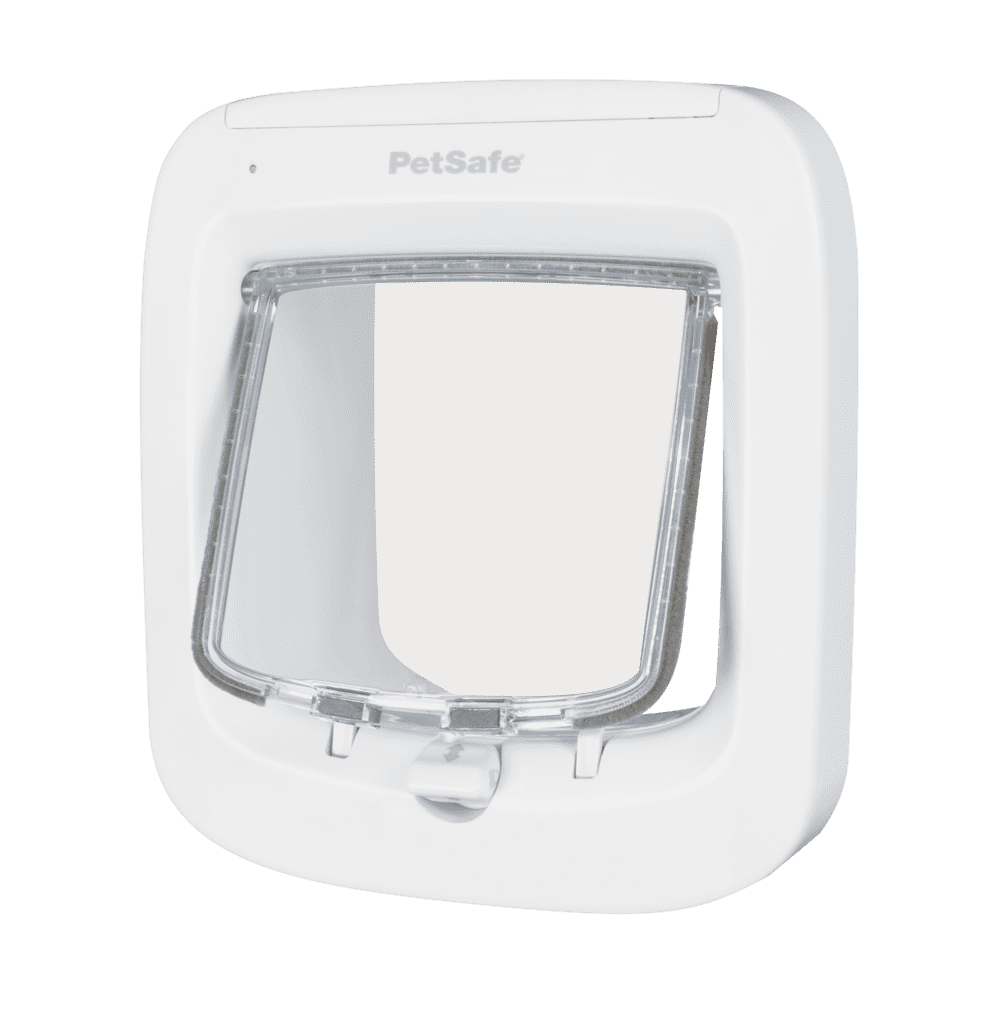Electronic, Automatic & Microchip Pet Doors
- A hassle-free solution to unwanted critters with a pet-only unlocking system.
- Selective entry options for different pets, ensuring personalized access.
- Wide range of door styles to cater to all pet needs, including those with physical limitations.
Filters
Filter your search
Pet Type
Window Type
Door Type
Weather Type
Pet Size
What Matters Most?
Wall Thickness
Frame Material
Flap Material
Brand
Additional Features
Color
Installation Difficulty Level
What Do You Need to Do?
Warranty
Pet Type
Door Type
Weather Type
Pet Size
What Matters Most?
Flap Material
Brand
Additional Features
Color
What Do You Need to Do?
Warranty
-
PetSafe Electronic Smart Door
 PetSafe Electronic Smart Door
PetSafe Electronic Smart Door- Regular price
- from $169.99
- Sale price
- from $169.99
- Regular price
-
$139.00 - Unit price
- /per
Sale Sold out -
High Tech Power Pet Patio Pet Door (Original and WiFi)
 High Tech Power Pet Patio Pet Door (Original and WiFi)
High Tech Power Pet Patio Pet Door (Original and WiFi)- Regular price
- from $979.99
- Sale price
- from $979.99
- Regular price
-
- Unit price
- /per
Sale Sold out -
High Tech Power Pet Door Mount Dog Door (Original and WiFi)
 High Tech Power Pet Door Mount Dog Door (Original and WiFi)
High Tech Power Pet Door Mount Dog Door (Original and WiFi)- Regular price
- from $539.99
- Sale price
- from $539.99
- Regular price
-
- Unit price
- /per
Sale Sold out -
High Tech Power Pet Wall Mount Dog Door (Original and WiFi)
 High Tech Power Pet Wall Mount Dog Door (Original and WiFi)
High Tech Power Pet Wall Mount Dog Door (Original and WiFi)- Regular price
- from $609.99
- Sale price
- from $609.99
- Regular price
-
- Unit price
- /per
Sale Sold out -
PetSafe Microchip Cat Door
 PetSafe Microchip Cat Door
PetSafe Microchip Cat Door- Regular price
- $139.99
- Sale price
- $139.99
- Regular price
-
- Unit price
- /per
Sale Sold out -
PetSafe SmartDoor Connected Pet Door for Cats and Dogs
 PetSafe SmartDoor Connected Pet Door for Cats and Dogs
PetSafe SmartDoor Connected Pet Door for Cats and Dogs- Regular price
- from $549.99
- Sale price
- from $549.99
- Regular price
-
$0.00 - Unit price
- /per
Sale Sold out
Explore the world of electronic, automatic, and microchip pet doors, designed with advanced technology to ensure security and convenience for both you and your pet. A dog door with sensor unlock exclusively for your pet, keeping neighborhood cats and other unwanted animals at bay.
What sets these doors apart is the selective entry feature, ideal for households with multiple pets. Imagine a scenario where you can allow your dog to venture outdoors while ensuring your indoor cat stays safely inside – all possible with our range of RFID and microchip-activated doors.
There is an array of styles, from traditional door and wall mounts to innovative sliding glass door inserts, complete with a motorized flap. This feature is particularly beneficial for timid or arthritic pets, providing them with effortless access to the outdoors. As for those who own larger breeds, the High Tech WiFi Controlled Power Pet Door
is the only electronic option available in the market designed specifically for larger dogs.
These pet doors employ different types of electronic door keys to suit various needs. This includes the Vet-Implanted ID Microchip, which eliminates the need for a collar and provides a safe and practical solution for pets. There is also Magnetic Collar Keys, with options for both non-power requiring and battery-powered versions.
For those preferring sound-based mechanisms, there's the Ultra-Sonic Collar Keys, although they require regular battery checks and are not suitable for pets that swim. Similarly, Radio-Frequency Chip Collar Keys operate on high-frequency sound, with the same considerations as the Ultra-Sonic keys. Lastly, the RFID Chip Collar Keys, such as those used in the popular PetSafe Smart Door, emit a unique radio frequency signal, with the door locking and unlocking based on the signal's detection.
Choosing an electronic pet door isn't just about convenience, but also about control and security. Some models offer one-way access control, while others offer bi-directional control, providing the flexibility to manage indoor and outdoor access for your pets. They also aid in keeping clever intruders like raccoons out of your home. And for the timid or arthritic pets, motorized electronic pet doors provide the greatest ease, opening automatically as they approach.
Power requirements for these pet doors vary, with some requiring no power source at all, while others operate on batteries, AC power, or even a combination of both. Regardless of the power source, all electronic pet doors aim to enhance the freedom and comfort of your pet, while providing you with the peace of mind you deserve.
With their diverse features, electronic pet doors are a significant investment. But just like any technology, they come with potential challenges like reliability and cost. However, the benefits of these doors, such as enhanced security, selective access, and convenience for pets, make them a worthy addition to any pet-friendly home.
Experience the innovative world of electronic pet doors, where pet comfort meets advanced technology for an effortless and secure pet experience.
Frequently Asked Questions
Some electronic pet doors control access from outside only, while others are controllable from both sides. What difference does this make?
In most cases, the one-way, outside access control only works fine. Here are the situations in which 4-way access control from both directions can be an advantage: You want to keep an inside pet (or child) from going outside in addition to preventing strays and other animals from coming inside. You are concerned about raccoons coming in through the pet door. At least some raccoons have figured out that a one-way control electronic pet door can be broken into by hooking the flap with a claw and pulling the flap toward the outside. Then they can come through the opening. No one knows if every raccoon can do this, but they are very clever.
Do you have any electronic doors that keep out woodchucks, raccoons, squirrels and other cats in the neighborhood?

Yes! You will need an electronic pet door that can control who enters and exit the home. Many electronic cat doors only control who has access coming in, which can be easily foiled by racoons.
Some of our favorite critter and racoon-proof doors include the PetSafe SmartDoor Connected Pet Door, Cat Mate Elite 305/306, PetSafe Microchip Smart Door, and High Tech Power Pet Door. These doors are all raccoon-resistant and will keep out strays.
Some electric pet door models are motorized while others require the pet to push the flap after unlocking. What’s the difference?
Motorized electronic pet doors always control from both directions: non-motorized versions may be either one-way or two-way control. A timid, arthritic, or injured pet may find it easier to use a motorized version since he doesn't need to learn to push anything; the door simply opens in front of him. This is probably the most significant advantage of a motorized pet door. We suspect that the motorized versions may be slightly less able to keep a second pet from following the first out. It's true that the time the flap remains open can be made short. But it's still open to all during that time. The must-push versions present a following pet with a flap swinging toward him as the leader clears the flap door. That would seem to be a more effective deterrent. Manual flap systems may be used in a non-electronic mode; motorized pet doors cannot.
What are the different power requirements of electronic pet doors?
As we've seen above, some magnetic dog and cat doors require no power source at all, neither for the door nor for the collar key. For the remaining electronic pet doors, there are four possibilities: Some are operated by batteries only Some may be operated with AC power thus requiring a nearby wall outlet. At least one, the Hi-Tech Power Pet, can use AC Power with a battery backup in addition to the first two options. With an electrician's help, you might be hardwired by the pet door.
What problems are there with electronic pet doors?
The first is reliability. With electronic doors, there are more issues that are likely to occur. If a manual pet door works for you and your pet, we would definitely recommend the manual door as a better option. An electronic door can run into issues like a dead battery since there's no battery level indicator; this problem could occur unexpectedly and would hinder your pet from entering/exiting. On the other hand, the only time a manual pet door would stop your pet from entering/exiting is if you personally put the locking cover on. Cost. Electronic pet doors, particularly the motorized versions, tend to be more expensive than manual pet doors. Lost collars and keys can add up, too. Although there certainly are some high-performance manual pet doors that are quite expensive as well. Rigid Flaps. All electronic pet doors incorporate rigid flaps. However, some people prefer a flexible flap for reasons of safety and a softer surface for the pet to push. In this regard, it should be noted that the motorized pet doors do not offer the pinching danger of a normal rigid flap. Insulation and Energy Efficiency. Most of these direct approach electronic doors do not have magnets or even a weather stripping lining on their flaps, making them more likely to leak air and let in the cold. Most energy-efficient pet doors are not electronic.
What does it mean to "control both ways?"
The option to control both ways allows the door to control which animals can enter and exit. This simple directional sensing system can prevent animals such as raccoons from getting inside, as well as keep your pet or even child inside when necessary. Access from both directions can be an advantage if you want to keep an inside pet (or child) from going outside while also preventing outside animals from getting inside without a cat or dog's collar key. We recommend the PetSafe Smart Door, High Tech, and Cat Mate 305/306.

I want my dog to be able to get in and out of the house, but not my cat, which pet door would work for that?
The PetSafe Electronic Smart Door would be a good choice that allows for this type of functionality for dogs.
How is the PetSafe Electronic Smart Door powered?
This smart door is powered by "D" cell batteries, which are not included. There is no low battery indicator on the Electronic Smart Door so it might be useful to keep a spare collar key nearby for testing purposes.
How big are the collar keys on the different electronic doors?
Microchips are collarless, as they are surgically implanted by your vet. RFID tags tend to be smaller because they don't need batteries. Battery run tags are bulkier because there needs to be space for a battery to be held in there.
What's the biggest electronic pet door you have?
The PetSafe Smart Door and the High Tech.
Can I get a microchip dog door for my Lab?
Unfortunately, there are currently no dog doors or large cat doors available that use microchip technology for a bigger animal like a Lab. There are microchip doors for smaller dogs and cats, however. If you want an automatic dog door for large dogs, they'll need to have a collar key.
Can the large dog doors be programmed to only allow access during parts of the day?
Yes, the High Tech Power Pet Door (if connected to a timer).
Are there any patio pet door panels that have a microchip cat door installed into it?
At this time, no. Your options for either a microchip cat door or a electronic patio panel are limited. If you absolutely need the microchip cat door, then we would recommend installing the PetSafe SmartDoor Connected Pet Door into your glass pane with an adapter. If you absolutely need the patio panel insert function, the High Tech Pet Door would be right for you.
Do magnetic locking pet doors require power?

Magnetic locking pet doors do not require power. However, Electromagnetic Pet Doors like the Cat Mate 305 and Ideal “E” Cat Door require batteries.
Which electronic doggie door doesn't require batteries in the collar key?
The PetSafe Smart Door will generally be adequate for medium to large dogs, and they require the dog to still push the flap to get in and out. These two electronic doors differ from other electronic doors because these doors
My dog is not microchipped, what RFID dog door large dog size is available?
The PetSafe Electronic Smart Door, which has an RFID collar key.
What electronic pet door for garage door do you recommend?
There are a few, depending on your dog's size. There are the High Tech Power Pet Door and PetSafe Electronic Smart Door. There are no large dog microchip pet doors available due to the limited range of technology.
What options do you offer for a motion sensor pet door?
Pet doors with sensors come in many forms. The closest motion sensor pet door we offer would be the High Tech Power Pet Automatic pet door. They are available for installation indoor, walls, and sliding glass doors.
Why would you want the pet door to open without the pet pushing?
You would want a motorized door if your pet is timid, injured, older aged/arthritic, and unable to push on the flap of the door. A motorized pet door allows hassle-free entry and exit.
Are there any patio panel doors that control both ways?
Yes, the High Tech Power Pet Automatic Pet Door controls both ways.
Which electronic pet doors can have a rechargeable battery?
The High Tech Power Pet Door has a rechargeable battery, making them good for easy installation.
Do all electronic pet doors have low battery indicator lights?
Not all electronic pet doors have low battery indicator lights. Typically, just the smaller cat doors offer this feature.
Do the rigid flaps of motorized pet doors create a danger for pets or children?
The rigid flaps of motorized pet doors do not typically create a danger for pets or children because the flap is retractable and will lift back open if it senses something is in the way.

Is there a microchip door for sliding doors?
A good option for sliding doors is the High Tech Power Pet for Sliding Doors.
How many keys does each of the doors come with?
| Model | Number of Keys Included |
|---|---|
| High Tech Power Pet Automated Pet Door | 1 |
| Ideal E-Cat Electronic Door | 1 |
| PetSafe Smart Door | 1 |
| PetSafe Magnetic Cat Flap | 1 |
| CatMate 254/256 | 2 |
| CatMate 259 | 2 |
| CatMate 305/306 | 2 |
| DogMate 259 | 2 |
















